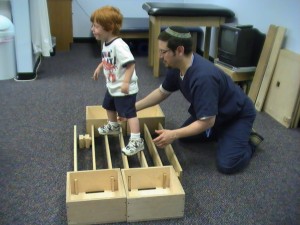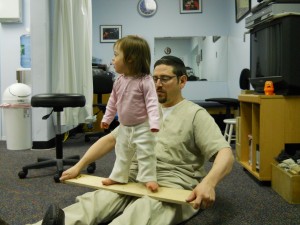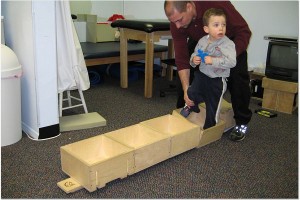
CME was created by Ramon Cuevas a Pediatric
Physical Therapist who lives and works in Santiago, Chile and travels the world teaching his technique and treating children with movement disorders. His therapy is unique because of the following characteristics.
I- It provoke the appearance of absent and automatic motor functions.
We try to work ahead of the child while being sure not to leave the child behind. Careful selection of exercises ensures that we are working on new motor skills instead of facilitating (or making easier) what the child is already capable of doing. We don’t have to follow the developmental sequence and may work on standing and walking prior to the child demonstrating sitting or crawling. The automatic control learned will help the children perform these skills as well.
II- The child’s cooperation and motivation are not required to make progress with CME

It would be better if we have the child’s cooperation and motivation, but therapy does not have to stop if the child is uncooperative, crying or presents with limited cognition.
We are eliciting and reinforcing automatic responses of functional-postural motor control that are pre-programmed in the brain but are not yet evident or functional for the child to perform upright against gravity. As long as the child is giving us these automatic reactions therapy can continue. The parent, an expert on their child, is present & involved in all therapy sessions especially to guide in this area.
III- Expose Body Segments to the Influence of Gravity Force with the gradual progression to controlling the child with the Use of DISTAL SUPPORT.
We provoke the absent anti-gravity control by holding the child as low down their body as possible. We constantly ask “How can we let go today?” This enables the child to hold themselves up against gravity, feel what it is like to do so, and gain consistent control in sitting, kneeling and standing. The therapist acts as a temporary surrogate nervous system to help the child control their own balance, keeping their weight over their base of support. The child  is constantly active and every exercise requires input by the therapist and an ACTIVE motor output on the part of the child.
is constantly active and every exercise requires input by the therapist and an ACTIVE motor output on the part of the child.
IV- ROM (Range of Motion) Exercises are incorporated in Dynamic and Active Exercises.
Passive ROM done on a cold muscle is risky. Active and dynamic stretching is done on a warm muscle in a functional way maximizing therapy time and stretching activities.
V- Hyper-Tonicity in the Lower Extremities and Mal-alignment of the Body is NOT NECESSARILY a Reason to Avoid Early Standing or Stop / Alter Therapy.
We don’t want to delay the sensation of and motor control in standing. By gaining control in this position, fixing and stiffening of the child’s body in this position can decrease.
VI- 8 Week Trial Period is employed to Determine Efficacy and avoids endless treatment.


